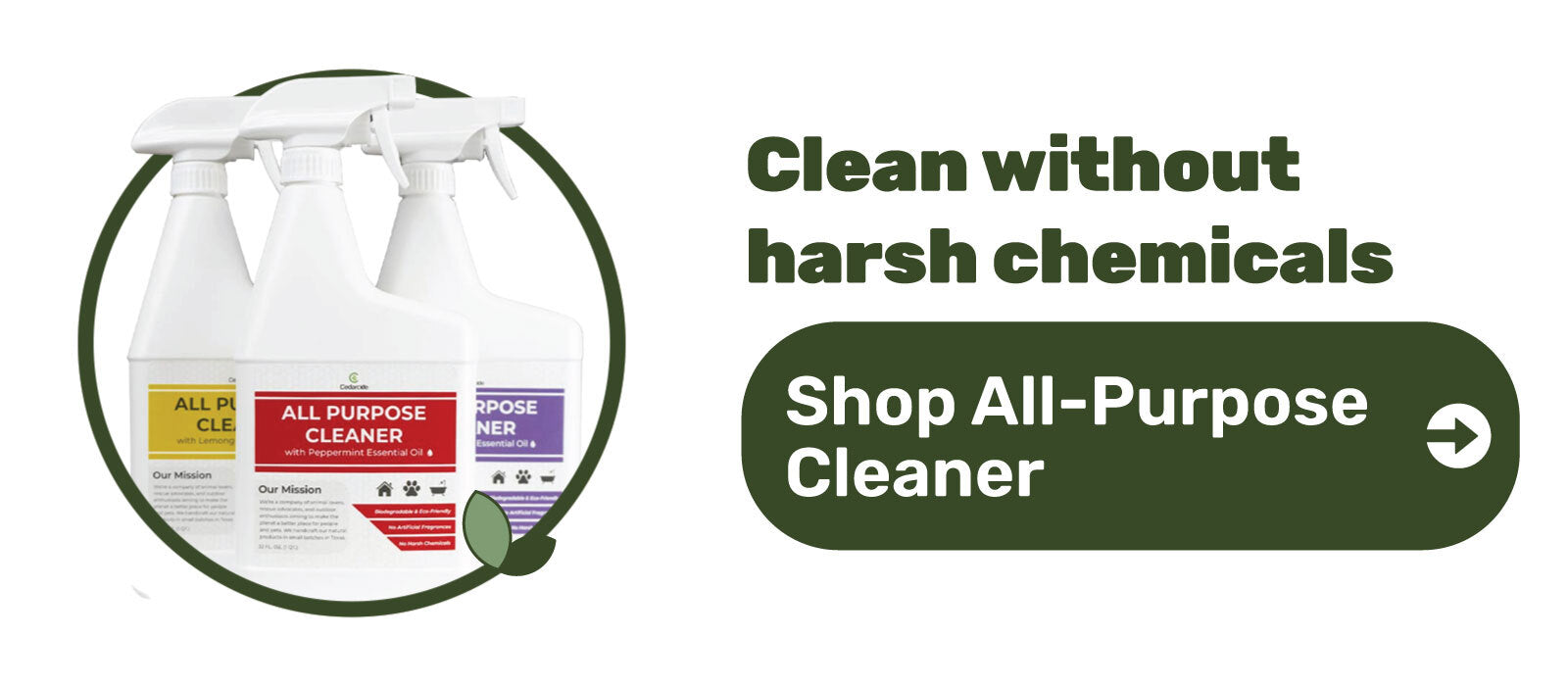
As responsible pet parents, we try to give our animals the best lives possible. We feed them awesome food, we entertain them with outdoor activities, treats and toys, and we protect them from harmful annoyances like fleas and ticks. But, there’s one arena that many pet parents don’t consider when it comes to their pet care routine and it’s arguably the most impactful: Household chemicals.
Many common items we consider safe—from air fresheners to plastic pet toys—actually contain toxins that can poison our cats and dogs, resulting in illness, sometimes even death. Thankfully, by being just a little more conscious, we can help make our pet’s environments safer and much less toxic. Here are 5 ways to reduce your pet’s exposure to harmful chemicals.
1. SAY NO TO ARTIFICIAL FRAGRANCES
Artificial fragrances—air fresheners, candles and other synthetically scented products—often contain chemicals that are unsafe for your pets, including heavy metals, phthalates, and VOCs (volatile organic compounds) like ethanol and formaldehyde.
Devastating health effects associated with consistent and long term exposure to these chemicals include heart disease, respiratory problems, birth defects, reproductive complications, even cancer.
But how common are these chemicals? Sadly, very. In a first-of-its-kind study, the EWG (Environmental Working Group) published the Polluted Pets report in 2008 to give the public a better understanding of the chemicals affecting our pets’ health. Their research found that American pets are riddled with phthalates, among other toxic chemicals found in artificial fragrances. Specifically, they discovered that dogs were contaminated with traces of phthalates at levels up to 4.5 times higher than humans; cats were contaminated at levels higher than in any of the over 5,500 people tested by the CDC.
Thankfully, from essential oils to natural air fresheners, there are numerous non-toxic and naturally sourced alternatives to artificial deodorizers and synthetic air fresheners.
2. SWITCH OUT YOUR HOUSEHOLD CLEANERS
Indoor air pollution affects more than just our homes’ air quality, it impacts our pets’ health and lifespans, too. Many traditional household cleaners contain bleach, formaldehyde, ammonia, chlorine and other toxic ingredients and synthetic fragrances that fill our home with noxious contaminants. Through inhalation, incidental ingestion, and absorption from the floor, our pets are commonly exposed to these chemicals, and the risks can be dire: Cancer, anemia, organ damage and more have all been linked to these toxins.
To protect your pets from potentially harmful exposure, carefully read cleaner labels and consider switching to non-toxic alternatives the next time you go shopping.
3. CHOOSE NON-TOXIC FLEA & TICK CONTROL
Pills, collars, sprays—in whatever form, traditional flea and tick solutions can pose a significant health risk to not only your pets, but also you and your family. Common ingredients in these products, such as organophosphates, carbamates, and pyrethroids, have been linked with countless health complications in both animals and humans. Organ damage, seizures, cancer, nervous system damage, and death in pets have all been associated with toxic flea and tick repellents.
Frighteningly, it’s been shown that synthetic flea and tick products can persist on our pets’ fur for weeks after initial application. Research has revealed that concentrations of these remaining pesticide residues pose a risk of cancer and neurological damage to children “up to 1,000 times higher than the EPA’s acceptable levels.”
To limit your pet and family’s exposure to these potentially life altering ingredients, consider switching from conventional flea and tick prevention products to non-toxic solutions without harsh chemicals.
4. DITCH THE PLASTIC TOYS
We mentioned above that a family of toxic chemicals called phthalates are typically present in artificial fragrances. Another common use for Phthalates is to help make plastic products more flexible. Unfortunately, this includes our pets’ toys.
Given that these items all but live in our pet’s mouths, the idea that they contain possibly life changing chemicals is just a little more than unsettling. (If you recall, the aforementioned Polluted Pets Report study found that dogs were contaminated with phthalates at levels up to 4.5 times higher than humans, and cats were contaminated at levels higher than in any of the humans the CDC tested.)
In addition to limiting household fragrances to natural sources, avoiding plastic pet toys is essential to protecting your cat or dog from the effects of phthalate poisoning.
5. AVOID SYNTHETIC LAWN PRODUCTS
Traditional, chemical-based lawn care products present a unique danger to your pet’s overall health. Think about it: They spend considerable time outside, playing and lying in your lawn, and sometimes even eating its grass. Given the harmful chemicals hidden in many fertilizers, herbicides, and pesticides, sometimes a simple paw-lick is all it takes to negatively impact their health.
To start, conventional fertilizers often contain a noxious mix of phosphorus, nitrogen and other chemicals that at the right dose can be outfight fatal to pets, especially if ingested. The more pressing threat, however, is traditional outdoor pesticides. Alarmingly, several types of pet cancers are strongly linked with these products. One study, for example, found that dogs exposed to pesticides commonly used by lawn care services had a 70% higher risk of fatal canine malignant lymphoma.
Research published in the journal Science of the Total Environment discovered that “exposure to herbicide-treated lawns has been associated with significantly higher bladder cancer risk in dogs.” Another scary chemical to look out for is allethrin. This pesticide is found in many outdoor products used to treat flying pests like mosquitoes, and it’s been linked with increased risk of liver cancer in dogs. Considering cats absorb more chemicals than dogs due to their grooming habits and more delicate digestive systems, cat parents need to be extra careful around allethrin as well.




